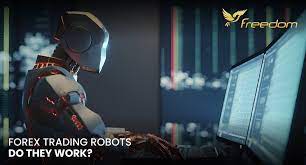In the dynamic world of financial markets, technology continues to reshape the landscape of trading, offering innovative solutions to investors worldwide. One such innovation that has gained significant traction in recent years is the forex robot – a sophisticated software designed to automate trading processes in the foreign exchange market. These automated systems, also known as expert advisors (EAs), have captivated traders with their potential to execute trades with precision, efficiency, and speed. Let’s delve into the realm of Forex robots, exploring their functionality, benefits, and the impact they have on modern trading strategies.
Understanding Forex Robots:
Forex robots are algorithmic trading systems programmed to execute trades on behalf of traders in the forex market. These robots operate based on predefined criteria and parameters set by traders or developers. They analyze market conditions, price movements, and technical indicators to identify trading opportunities and execute orders without human intervention.
The sophistication of Forex robots varies significantly, ranging from simple scripts to complex algorithms capable of executing intricate trading strategies. Some robots are designed to scalp small profits from rapid price fluctuations, while others employ trend-following or countertrend strategies to capitalize on broader market movements.
Key Features and Functionality:
Forex robots come equipped with a plethora of features and functionalities aimed at optimizing trading performance and minimizing risks. Some common features include:
- Automated Trading: The primary function of Forex robots is to automate the trading process, eliminating the need for manual intervention. Once activated, these robots continuously scan the market for trading opportunities and execute orders according to predefined parameters.
- Backtesting: Before deploying a Forex robot in live trading, users can conduct backtests to assess its performance using historical market data. Backtesting allows traders to evaluate the efficacy of their trading strategies and fine-tune parameters to optimize performance.
- Risk Management: Advanced Forex robots incorporate robust risk management tools to mitigate potential losses. These tools may include stop-loss orders, position sizing algorithms, and risk-reward ratio optimization to protect capital and preserve profits.
- Multi-Currency Support: Many Forex robots support trading across multiple currency pairs simultaneously, enabling traders to diversify their portfolios and capture opportunities in various market conditions.
- Customization: Traders have the flexibility to customize Forex robots according to their specific trading preferences and risk tolerance. They can adjust parameters such as entry and exit criteria, timeframes, and indicators to tailor the robot’s behavior to their individual trading strategies.
Benefits of Using Forex Robots:
The adoption of Forex robots offers several compelling benefits for traders:
- 24/7 Trading: Forex robots operate round the clock, enabling traders to capitalize on opportunities in global markets across different time zones, even when they are unable to monitor the markets actively.
- Emotion-Free Trading: One of the significant advantages of automated trading is the elimination of emotional biases that often plague human traders. Forex robots execute trades based on pre-established rules, free from fear, greed, or hesitation.
- Improved Efficiency: Forex robots can analyze vast amounts of market data and execute trades with lightning speed, far surpassing the capabilities of human traders. This efficiency allows for faster response to market conditions and timely execution of trading strategies.
- Consistency: By adhering strictly to predefined trading rules, Forex robots maintain consistency in trade execution, eliminating the inconsistency and variability that may arise from human decision-making.
- Diversification: With the ability to trade multiple currency pairs simultaneously, Forex robots enable traders to diversify their portfolios and spread risk across different instruments, enhancing overall stability and resilience.
Challenges and Considerations:
While Forex robots offer significant advantages, they are not without challenges and considerations:
- Market Volatility: Rapid changes in market conditions, particularly during times of high volatility, can pose challenges for Forex robots, potentially leading to unexpected outcomes or losses.
- Over-Optimization: Excessive optimization of trading parameters based on historical data may lead to overfitting, where the robot performs exceptionally well in backtests but fails to generalize to live market conditions.
- Technical Issues: Forex robots are susceptible to technical glitches, connectivity issues, or software bugs that could disrupt trading operations and result in missed opportunities or losses.
- Lack of Adaptability: While Forex robots excel in executing predefined trading strategies, they may struggle to adapt to sudden market shifts or unforeseen events that require nuanced decision-making.
- Dependency on Market Conditions: The efficacy of Forex robots is highly dependent on prevailing market conditions and the relevance of underlying trading strategies. Certain strategies may perform exceptionally well in specific market environments but falter in others.
Conclusion:
Forex robots represent a paradigm shift in the

